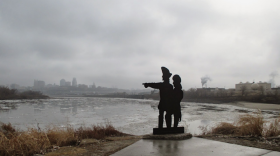Stephen A. Ambrose says, in Undaunted Courage, that the Fourth of July on the Missouri River began with shooting off "the cannon." Comes as a shock almost. Lewis and Clark packed that kind of heat?--an actual cannon on board? Sheesh.
Yes and no. Simply making headway through the wily Missouri River' sandbars was enough trouble. And then, on top all of that, they lugged along a cannon?
John Ordway, as others, calls it a "Bow piece." That's a mite better than "cannon" methinks. What ornamented (and that's not far from the truth) the front of "the boat," as the men described the biggest vessel of their armada, was anywhere from 18 inches to 36 inches long--not that humongous.
Still, the cannon was meant as a weapon of war, should war break out. It sounds a little vainglorious to say it this way, but it's true: war was not the intention; peace was. Lewis and Clark--unless they lied their way through their own journals--were embarked on a business venture. First and foremost, they were explorers in the best 19th century definition of that word; Jefferson wanted to know everything about this unmapped chunk of land he'd bought from the French.
But L and C were also out there on business. The fur trade was big money, and the French were in it, as were the English, both big-time. They were all making money on beaver and an occasional buffalo hide, and Jefferson wanted to secure control of the business already going on out west in his new country. That might be best accomplished, he thought and thusly directed L and C, by meeting with the Indigenous and letting them know that there was a new Great Father in town, and that Great Father wanted to work with them, not against them.
Amazing as it may seem, no matter what you call it, that cannon on the keelboat never took aim at any human being, not up or back, not for two long years. Still, even though nobody shot at anybody, lugging that "bow piece" along turned out to be immensely useful. Hunting and scouting parties went out frequently, looking for game, looking for Native people. After a day or two absences, the men couldn't help but wonder where the others might be. Voila! the cannon. Boom!--a welcome call home.
Besides that, that "Bow piece" went off for celebration too. On July 4, "we fired our Bow piece this morning & one in the evening for Independence of the U. S." says John Ordway, and then, same sentence, no end punctuation, "we saw a nomber of Goslins half grown to day." Wasn't much of a celebration, but it got a half sentence in Ordway's journal."
You can keep this information to yourself, but the men were given a double shot of whiskey that night on the occasion of the birthday of the United States of America. Prost!
I'm not at all sure if Ordway wrote this last sentence before or after that extra gill of whiskey (about four ounces), but the what he says about what he saw is sweet, whether he was a little holiday happy or not: "One of the most beautiful places I ever Saw in my life, open and beautifully Diversified with hills & vallies all presenting themselves to the River."
That extra gill of whiskey and a couple of rounds from an 24-inch cannon constituted the very first Fourth of July celebration west of the Mississippi. By all accounts, it was a good day.








